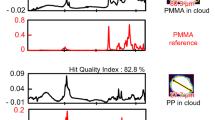Abstract
Traditionally, the atmospheric particle composition is analyzed using destructive methods. In general, the destructive methods lead to the destruction of the samples, higher cost of the analysis and larger analysis time. In view of aforesaid, in current work, we present a method for the non-destructive analysis of atmospheric particles using open path-Fourier transform infrared spectroscopy (OP-FTIR). The developed method has been used for the measurement of ammonium and sulfate in atmospheric particles without destroying the samples. Here, we targeted the said species because of their relative importance for air pollution episode formation. Particulate sulfate plays a major role in formation of haze. However; particulate acidity is an important factor in this process, which is governed by particulate ammonium concentration. Therefore, both SO42− and NH4+ are important as far as atmospheric chemistry of haze formation is concerned. In the present study, the qualitative and quantitative estimation of ammonium and sulfate ions in PM2.5 (particulate matter with aerodynamic diameter less than 2.5 µm) was carried out using OP-FTIR with the developed method. The seasonal average concentration of NH4+ and SO42− were measured to be 12.00 ± 5.80, 31.71 ± 12.71 µg/m3 respectively for winters, 3.00 ± 0.85 and 8.00 ± 2.28 µg/m3 respectively for summers and 2.60 ± 1.90 and 7.00 ± 5.21 µg/m3 respectively for monsoon season. The observed results are found to be in good agreement with that of other studies using destructive methods.
Similar content being viewed by others
References
S. Guo, M. Hua, M.L. Zamora, J. Peng, D. Shang, J. Zheng, Z. Du, Z. Wu, M. Shao, L. Zeng, M.J. Molina and R. Zhang, Elucidating severe urban haze formation in China, Proc. Natl. Acad. Sci., 111 (2014) 17373–17378.
J.H. Seinfeld and S.N. Pandis, Atmospheric chemistry and physics: from air pollution to climate change, 2nd edn, Wiley, Hoboken, NJ, (2006).
K.-H. Kim, E. Kabir and S. Kabir, A review on the human health impact of airborne particulate matter, Environ. Int., 74 (2015), 136–143.
S. Fuzzi et al., Particulate matter, air quality and climate: lessons learned and future needs, Atmospheric Chem. Phys., 15 (2015), 8217–8299.
U. Pöschl, Atmospheric aerosols: composition, transformation, climate and health effects, Angew. Chem. Int. Ed., 44 (2005), 7520–7540.
S. Gupta, S.K. Mittal and R. Agarwal, Respiratory health of school children in relation to their Body Mass Index (BMI) during crop residue burning events in North Western India, MAPAN-J. Metrol. Soc India (2017) 1–10. https://doi.org/10.1007/s12647-017-0245-1.
Y. Sun, G. Zhuang, A. Tang, Y. Wang and Z. An, Chemical characteristics of PM2.5 and PM10 in Haze–Fog episodes in Beijing, Environ. Sci. Technol., 40 (2006), 3148–3155.
J. Tan, J. Duan, K. He, Y, Ma, F. Duan, Y. Chen, J. Fu, Chemical characteristics of PM2.5 during a typical haze episode in Guangzhou, J. Environ. Sci., 21 (2009), 774–781.
J. Lelieveld, J.S. Evans, M. Fnais, D. Giannadaki and A. Pozzer, The contribution of outdoor air pollution sources to premature mortality on a global scale, Nature, 525 (2015), 367–371.
S.K. Mishra, N. Saha, S. Singh, et al., Morphology, mineralogy and mixing of individual atmospheric particles over Kanpur (IGP): relevance of homogeneous equivalent sphere approximation in radiative models, MAPAN-J. Metrol. Soc India, 32 (2017), 229–241.
D. W. Clow, H.A. Roop, L. Nanus, M.E. Fenn and G.A. Sexstone, Spatial patterns of atmospheric deposition of nitrogen and sulfur using ion-exchange resin collectors in Rocky Mountain National Park, USA, Atmos. Environ., 101 (2015), 149–157.
S.M. Simkin, D.N. Lewis, K.C. Weathers, G.M. Lovett and K. Schwarz, Determination of sulfate, nitrate, and chloride in throughfall using ion-exchange resins, Water. Air. Soil Pollut., 153 (2004), 343–354.
J. W. O’Reilly, G.W. Dicinoski, M.J. Shaw and P.R. Haddad, Chromatographic and electrophoretic separation of inorganic sulfur and sulfur–oxygen species, Anal. Chim. Acta, 432 (2001), 165–192.
P. Pant, A. Shukla, S.D. Kohl, J.C. Chow, J.G. Watson and R.M. Harrison, Characterization of ambient PM2.5 at a pollution hotspot in New Delhi, India and inference of sources, Atmos. Environ., 109 (2015), 178–189.
Y. You et al., Images reveal that atmospheric particles can undergo liquid-liquid phase separations, Proc. Natl. Acad. Sci., 109 (2012), 13188–13193.
J. Ofner, H.-U. Krüger, C. Zetzsch and H. Grothe, Direct deposition of aerosol particles on an ATR crystal for FTIR spectroscopy using an electrostatic precipitator, Aerosol Sci. Technol., 43 (2009), 794–798.
S.K. Verma and M.K. Deb, Direct and rapid determination of sulphate in environmental samples with diffuse reflectance Fourier transform infrared spectroscopy using KBr substrate, Talanta, 71 (2007), 1546–1552.
D.T. Allen, E.J. Palen, M.I. Haimov, S.V. Hering and J.R. Young, Fourier transform infrared spectroscopy of aerosol collected in a low pressure impactor (LPI/FTIR): method development and field calibration, Aerosol Sci. Technol., 21 (1994), 325–342.
X.L. Wei, M.G. Gao, J.G. Liu and L. Xu, Quantification of sulphate in ambient aerosols by FTIR spectroscopy, Adv. Mater. Res., 718–720 (2013), 1136–1139.
M.V.S.N. Prasad, C. Sharma, B.C. Arya, et al., Experimental facilities to monitor various types of atmospheric parameters in the Radio and Atmospheric Sciences Division (RASD) of CSIR-National Physical Laboratory, MAPAN-J. Metrol. Soc India, 28 (2013), 193–203.
S. Yadav and V. Rajamani, Air quality and trace metal chemistry of different size fractions of aerosols in N–NW India—implications for source diversity, Atmos. Environ., 40 (2006), 698–712.
B. Sarangi, S. G. Aggarwal, P.K. Gupta, Performance check of particle size standards within and after shelf-life using differential mobility analyzer, J. Aerosol Sci., 103 (2017), 24–37.
S.K. Mishra and D. Khosla et al., SEM-EDS and FTIR characterization of aerosols during Diwali and Post Diwali festival over Delhi: implications to human health, J. Environ. Nanotechnol., 5 (2016), 12–26.
S. Tiwari, M.K. Srivastava and D.S. Bisht, Chemical characteristics of water soluble components of fine particulate matter, PM2.5, at Delhi, India, e-Journal Earth Science India, 1 (2008), 72–86.
P. Kumar and S. Yadav, Seasonal variations in water soluble inorganic ions, OC and EC in PM10 and PM > 10 aerosols over Delhi: influence of sources and meteorological factors, Aerosol Air Qual. Res., 16 (2016), 1165–1178.
M. Saxena, A. Sharma, A. Sen, P. Saxena, Sarasvati, T.K. Mandal, S.K. Sharma, C. Sharma, Water soluble inorganic species of PM10 and PM2.5 at an urban site of Delhi, India: seasonal variability and sources, Atmospheric Res., 184 (2017), 112–125.
D.K. Deshmukh, M.K. Deb, Y.I. Tsai, S.L. Mkoma, Water soluble ions in PM2.5 and PM1 aerosols in Durg City, Chhattisgarh, India, Aerosol Air Qual. Res. 11 (2011), 696–708.
R. K. Pathak, W. S. Wu, and T. Wang, Summertime PM2.5 ionic species in four major cities of China: nitrate formation in an ammonia-deficient atmosphere, Atmospheric Chem. Phys., 9(5) (2009), 1711–1722.
Acknowledgements
Authors are thankful to the Director, CSIR-National Physical Laboratory, New Delhi, India for his consistent support for the ongoing work.
Author information
Authors and Affiliations
Corresponding author
Rights and permissions
About this article
Cite this article
Goel, V., Mishra, S.K., Sharma, C. et al. A Non-destructive FTIR Method for the Determination of Ammonium and Sulfate in Urban PM2.5 Samples. MAPAN 33, 209–215 (2018). https://doi.org/10.1007/s12647-018-0253-9
Received:
Accepted:
Published:
Issue Date:
DOI: https://doi.org/10.1007/s12647-018-0253-9









